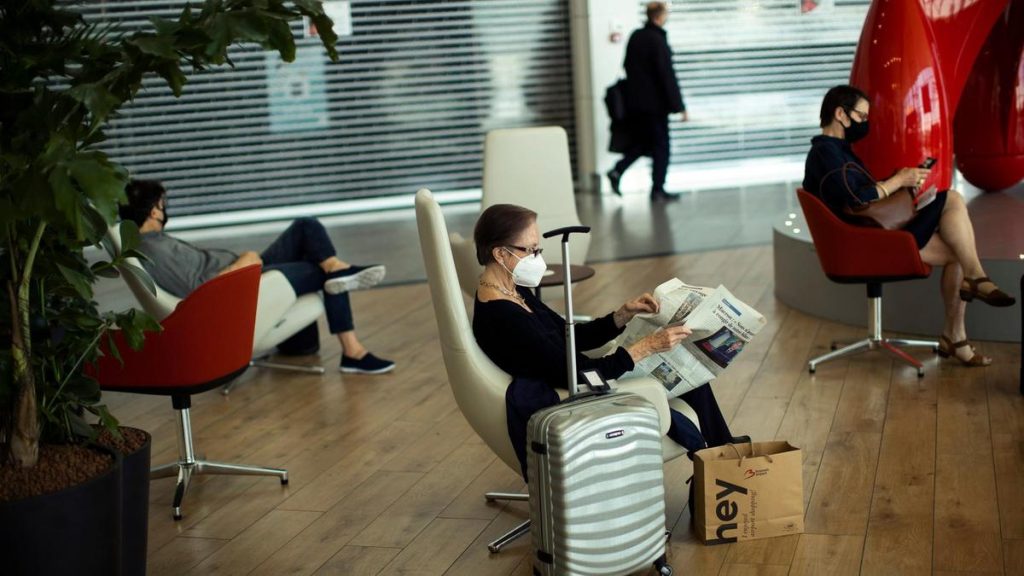Corona-alliances, travel corridors and air bridges: taking a flight is no longer business as usual

Passengers in the waiting area prior to their flight departures at the Zaventem international airport in Brussels, June 15. Borders opened up across Europe on Monday after three months of coronavirus closures that began in March. AP
While there is neither vaccine for cure for Covid-19, international travel is tentatively resuming in a strange new world of bubbles large and small, air bridges, green lanes, negotiated corridors and colour-coded zones.
The cartographical features of the new travel order are not yet set but it is safe to say they will be unique. The world — before the Cold War and after — has not seen the likes of such a reordering where borders will now be epidemiological.
Sometimes, they may even fall within countries. Rich and powerful nations that previously enjoyed easy access to much of the planet will now face limits. The pandemic is not just changing how we travel, but where, when and if at all.
The most distinctive feature of this remade world map is the changed definition of security blocs. For the moment, they are not military, nor determined by foreign policy doctrine so much as coronavirus infection rates. Jurisdictions that have managed to control the virus, at least for now, want to link up to create safe zones for the reopening of tourism and business travel.
On Monday, the European Commission urged European Union member states to lift internal border controls and quarantine obligations. It cited “a continuous positive trend… with regard to the epidemiological situation” and suggested it was time to restore borderless travel, that cornerstone of European integration. Except for Spain, which is holding out until June 21, most EU countries have largely heeded the advice. Mainland Europe has thereby become one of the largest travel bubbles in the post-pandemic world.

It is a policy that was pioneered by Latvia, Lithuania and Estonia. In mid-May, the Baltic bloc became the first in Europe to establish a bespoke bubble that allowed free movement for citizens of all three countries. This was followed barely a fortnight later by Hungary and Slovenia, which huddled in together in their low-infection zone. This week, China and Singapore enter a bubble that permits limited travel without quarantine between the island city-state and six Chinese cities.
Singapore is also talking of multiple green lanes to be bilaterally negotiated with Australia, South Korea, New Zealand and Malaysia. The Association of Southeast Asian Nations plans to discuss other possible regional bubbles on June 26. Talks on a trans-Tasman bubble are proceeding apace between Australia and New Zealand, with smaller Pacific island nations such as Fiji and Vanuatu seeking to join.
Meanwhile Britain, which has a high virus infection rate but somewhat surprisingly introduced a 14-day quarantine for all international arrivals on June 8, is contemplating air bridges. Portugal, Turkey and Greece have expressed interest in transport corridors that would allow millions of British tourists to continue their usual practice of spending the lazy days of summer at Mediterranean resorts.
A substantial number of countries across the globe will not be able to enjoy the sights and sounds of life in America
The US is a noteworthy exception in the multiple discussions underway around the world about bubbles and bridges. This is hardly surprising. The US has crossed the two million mark for confirmed coronavirus cases even as infection rates surge in several states in the west and the deep south.
With nearly a thousand people still dying every day in the US and a question mark over its policy failures on testing and tracing, it is hard to discern much enthusiasm for customised travel links between America and other parts of the world.
European destinations are, for the most part, off-limits to Americans. This is partly because of the principle of reciprocal treatment. The US banned travel from the EU on March 12, the day the World Health Organisation declared a global pandemic.
Accordingly, Portugal, an outlier among European countries for resuming nonstop flights between Lisbon and Newark airport in early June, only allows entry to Portuguese passport-holding visitors from the US.
In real terms though, it is epidemiological considerations that are hardening borders between the US and some other parts of the world.

In January, the Henley Passport Index of the world’s most travel-friendly passports showed US citizens enjoyed visa-free or visa-on-arrival access to 184 countries. But now, the European Commission’s newest directive warns against lifting travel restrictions from “third countries where the situation is worse” than on the continent.
Even tourism-reliant countries such as Thailand, which counts itself as effective in dealing with the pandemic, is expressing caution about the untrammelled entry of people from coronavirus hotspots.
On June 14, America’s leading public health official Dr Anthony Fauci indicated that US restrictions on international travel could remain in place for months on end, until a vaccine is developed.
This means that a substantial part of the globe — along with the EU, Britain, Brazil and China are also banned — will not be able to enjoy the sights and sounds of life in America, conduct business meetings in Silicon Valley or Wall Street and mix with diplomats and think tanks in Washington, DC.
What is striking about the new cartography is the trust bubbles contemplated by countries across regions and political divides. ‘Corona-alliances’ remake geopolitics using very different metrics. Bilateral or multilateral, the proposed agreements for cross-border travel without quarantine measures underline a commonality.
The shared experience could be equivalent or lower risks of coronavirus community transmission, a similar commitment to testing and contact-tracing, or more simply, a competent response to the pandemic. It says something that the US, the world’s richest, most powerful country, is not part of that conversation.
Originally published at https://www.thenational.ae

